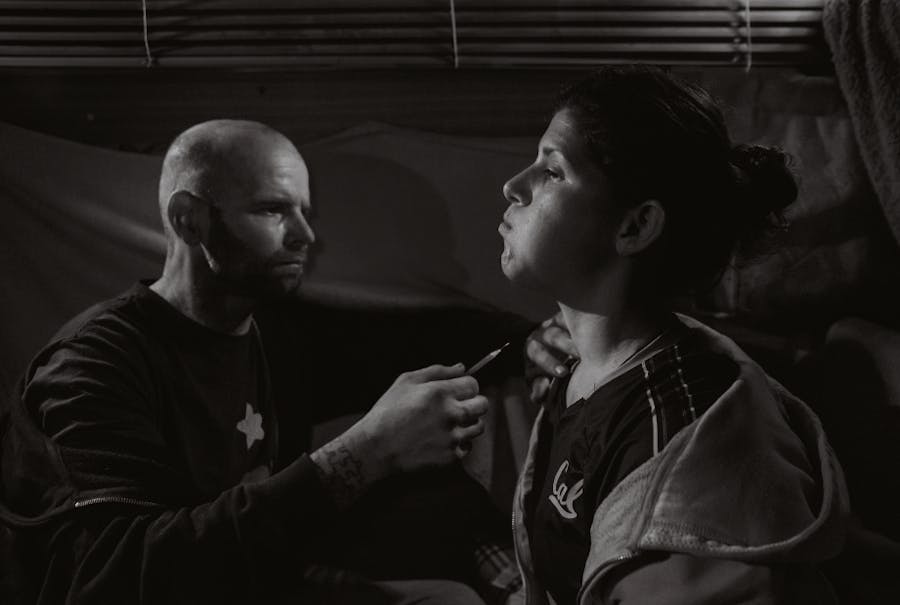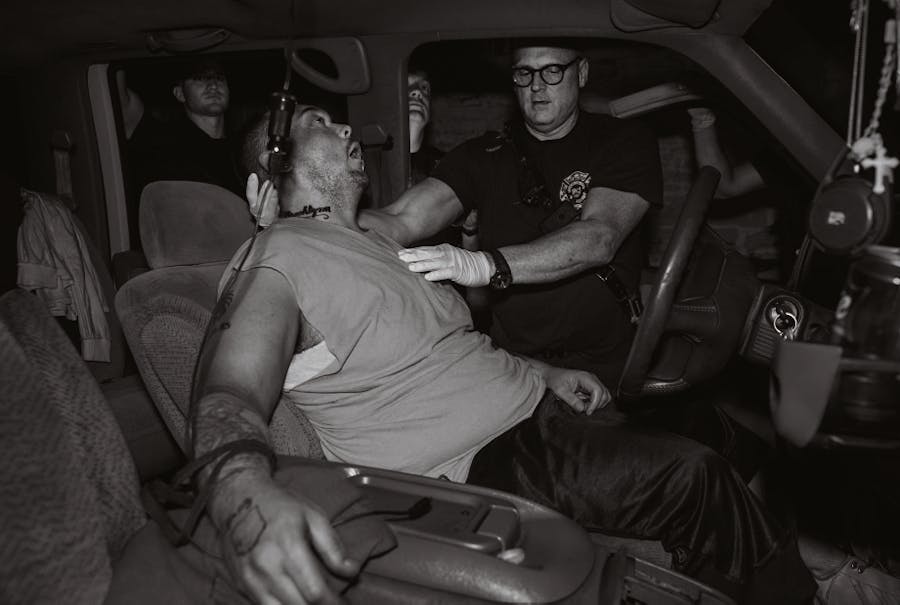The Opioid Diaries
Photographs by James Nachtwey

‘I was 17 when I started shooting heroin. Since then, I’ve gotten clean, gotten high again, gotten clean, gotten high. I’ve always been good at finding veins. You’ve got to blow up your cheeks to make the vein pop out so you can hit it.’
bobby lee, 45, injecting a friend inside his van in San Francisco on Jan. 30
From the Editors
“The fact that he’s still alive means that there’s hope,” says Kristina Barboza from her living room in East Wareham, Mass., 50 miles and a world away from where her 31-year-old son Billy sleeps beneath a Boston overpass. In Huntington, W.Va., firefighter Larry Kishbaugh—haunted by the countless overdose scenes he has rushed to—has been diagnosed with posttraumatic stress disorder. Inside a holding cell at the Kenton County, Kentucky, detention center where drug users are left to detox, 29-year-old mother Kayla Rauck wonders if she’ll ever see her children again.
It is hard to fathom, and bitterly ironic: the depth of the suffering caused by drugs whose ostensible purpose is to alleviate pain. Statistics offer a partial view of the wreckage. In 2016 alone, nearly 64,000 Americans died from drug overdoses—roughly as many as were lost in the entire Vietnam, Iraq and Afghanistan wars combined. The U.S. is the world’s richest country, and yet its life expectancy declined in both 2015 and 2016. More than 122 people die every day from syringes of heroin, gelcaps of fentanyl, an excess of oxycodone. Far more come close, but are revived by naloxone, a lifesaving antidote that has become nearly as critical to a cop’s job as handcuffs.
But numbers aren’t neighbors, and it is far too easy to become numb to their scale. We are in the midst of a national emergency that affects every state, every income group and virtually every age. While the burden has fallen disproportionately on the least-educated Americans, tens of millions of us are no more than one degree of separation from someone struggling with addiction. As Walter Bender, a deputy sheriffin Montgomery County, Ohio, put it, “It reaches every part of society: blue collar, white collar, it reaches everybody.”
Pharmaceutical companies helped spark this epidemic by aggressively marketing opioids as low-risk solutions for long-term chronic pain. We now know that they’re anything but low-risk—and yet drugmakers have continued to push opioids and reward doctors who prescribe them. Attempts to crack down on prescriptions have helped, but Americans are still prescribed far more opioids than anyone else in the world—enough for almost every adult in the country to have their own bottle of pills.
Political efforts in Washington have also been insufficient. In October, the White House declared a public-health emergency but did not grant any additional money for the crisis. The position of drug czar remains unfilled, and a limit on Medicaid reimbursements for large facilities remains in place, though the President’s own opioid commission suggested that lifting it would be “the single fastest way to increase treatment availability across the nation.”
This issue of TIME, the first in our 95-year history devoted to the work of a single photographer, is an effort to go beyond charts and policy. Over more than three decades, James Nachtwey has photographed war, famine and terror around the world for TIME. He was at the Twin Towers as they crumbled on Sept. 11 and in Baghdad as American tanks rolled in. His haunting images of withered bodies in Somalia put a spotlight on starvation there, helping save 1.5 million people. Nachtwey goes where others desperately try to flee, enduring gunfire and grenades out of the belief that the only way to stop the suffering is by bearing witness to it.

‘Heroin grabs ahold of you, and it won’t let go. It turned me into somebody I never thought I would be.’ chad colwell, 32, being revived by EMS workers after overdosing in his truck in Miamisburg, Ohio, on July 4, 2017. He says this, his fourth overdose, led him to seek treatment
Last year, we asked Nachtwey to bear witness to a pressing human crisis in his home country. He and TIME’s Paul Moakley spent months on the streets of Boston and San Francisco, on patrol with first responders in Ohio, New Mexico and West Virginia, inside jail cells in Kentucky, funerals in New Hampshire and prayer meetings in Massachusetts. In all, they made thousands of pictures and videos and conducted more than 200 interviews. On the pages that follow, Nachtwey’s images are paired with voices and stories from the people on the front lines. The result is a human accounting of the toll opioids are taking on American life, the people behind the statistics.
From his mother’s kitchen table in miamisburg, ohio, chad colwell, 32, talked about how quickly the cycle can begin. “I played football in high school, and my knee and my back got injured,” he said as his 3-year-old daughter played outside. “I got prescribed painkillers, Percocet and Oxycontin, and then it just kind of took offfrom there.”
Prescriptions gave way to cheaper, stronger alternatives. Why scrounge for a $50 pill of Percocet when a tab of heroin can be had for $5? Synthetic opioids, which have flooded into the U.S. from high-volume labs in China and Mexico, are even more potent—and a potentially fatal dose costs less than a Big Mac. On July 4, emergency workers saved Colwell after he overdosed in the driver’s seat of his truck. He says it was his fourth OD.
Inside a rehab facility in West Virginia, Jason Burgard told of a similar spiral. “When the pain gets great enough, you get so desperate just to feel okay, just to feel right,” says Burgard, who is nearing 10 months of sobriety after years of addiction and relapses. “A lot of people say drugs or alcohol eventually stop working, that they don’t cover up pain as well toward the end. But heroin works. Heroin does its job.”
The toll is also high for those who deal with what happens after the heroin does its job.
Fire departments have been transformed into mobile emergency rooms. Police now carry drugs that block the brain’s opioid receptors, lest they themselves drop dead from an accidental sniffof confiscated Carfentanil. High schools have started to stock up on naloxone, with principals getting trained to administer the emergency drug.
“Our job has changed completely in the last seven to 10 years,” said Jan Rader, the fire chief of Huntington, W.Va., in January, one day after her department was called to three overdose deaths. “We learned how to fight fire and cut people out of cars, but it’s not going to go back to that.”
For some first responders, the recurring calls to the same addresses, the same victims, have created a calloused distance. For others, it has had the opposite effect. “We’ve become like hospice nurses,” says Rader’s colleague Kishbaugh, the firefighter diagnosed with PTSD. “We’ve hardened ourselves against severed limbs and burnt bodies, but it’s eating me up seeing the kids.”
The pain is deepest for the families of users, whose lives are swept up in a cycle of fear and hope, shame and despair. They try to cope, but often never escape. “I felt embarrassed, like ‘What did I do?’” says Justine Gingras-Gagnon, whose 24-year-old daughter Michaela struggled with addiction before she died in September. “Even though she was drugaddicted, she was just so alive. She was funny, she was smart. She was a 5-ft. 1-in., 103-lb. dynamite.”
The actor Philip Seymour Hoffman, who fatally overdosed after years of battling addiction, left behind a family. “When Phil died four years ago, I was so overwhelmed, vulnerable and cracked open that anger became my protective shield, the only thing between me and collapse,” wrote Hoffman’s wife Mimi O’Donnell, in an essay for this project. “I wondered if I had talked to more people, asked for more help—screamed louder—if it would have saved his life.”
Billy Merrifield, a captain with the Rio Arriba County sheriff’s office in New Mexico, knows that feeling well. He has spent his career saving lives—but was unable to save his own daughter. “I’ve experienced a ton,” he says, “but you can’t prepare for it when it comes to your own child.”
Further Reading: Time Magazine



Geen opmerkingen:
Een reactie posten